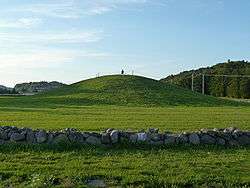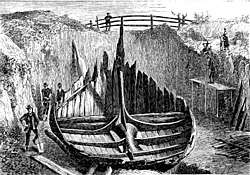Gokstad Mound


_(17813080994).jpg)
The Gokstad Mound (Norwegian: Gokstadhaugen) is a large burial mound at Gokstad Farm in Sandefjord (formerly Sandar municipality) in Vestfold County, Norway. It is also known as the King's Mound (Kongshaugen) and is where the 9th century Gokstad Ship was found. [1][2][3]
History
The mound was excavated by Nicolay Nicolaysen in 1880. The Gokstad Ship was constructed around 890 and was laid in the mound around ten years later. It mainly consists of oak and has a length of 23.8 meters (78 ft.) and width of 5.2 meters (17 ft.). It had 16 pairs of oars and its top speed is estimated as twelve knots.[4] The Gokstad Ship is now located at the Viking Ship Museum in Oslo.
Buried along with the ship was a petty king long believed to have been Olaf Geirstad-Alf, half-brother of Halfdan the Black.[5][6] However, recent discoveries have increased uncertainty and it therefore remains unknown what chieftain was buried at the mound.[7][8]
Gokstadhaugen has been described as one of Norway’s finest archeological finds.[9] The government of Norway applied to UNESCO in January 2014 to make the Gokstad Mound a World Heritage Site.[10][11]
Exhavation
The mound was in 1880 measured as 50 meters (164 ft.) in diameter, with a height of 5 meters (16.4 ft.).[12] The ocean water levels were significantly higher during the Viking Age, when the ocean stood nearly 4 meters (13 ft.) higher than today. It is therefore estimated that the ship was buried near the sea.
Artifacts found in the grave include a gaming board with counters of horn, fishing hooks, harness fittings (made of lead, iron and gilded bronze), 64 shields, kitchen utensils, six beds, a sleigh, as well as three smaller boats. Also found in the grave were two peacocks, two goshawks, eight dogs and twelve horses.[13]
The burial chamber was covered by layers of birch bark, and remnants of silk interwoven with gold thread have been discovered by archeologists stuck between the logs in the roof. These are possibly the remnants of a lavish woven tapestry that decorated inside walls.[13]
Dendrochronological studies prove the ship was constructed between year 885-892 AD. The burial chamber is dated to 895-903 AD.[14]
The buried chieftain was estimated to be 181-183 cm tall (5'9"-6'0"), and was killed around age 40 during a battle.[15]
The ship was discovered in 1879, and was excavated by Nicolay Nicolaysen between April-June 1880.[16] The mound was closed and the chieftain’s knuckles were returned to the grave site on June 16, 1928. The knuckles were put in a sarcophagus, and King Haakon VII was present at the official opening of the restored mound on July 29, 1929. The sarcophagus was brought out of the grave by archeologists in 2007, and is currently kept at the University of Oslo (UiO).[17]
References
- ↑ Holskjær, Lars (2017). Kamper uten tall. Forlagshuset i Vestfold. Page 200. ISBN 9788293407294.
- ↑ Hjardar, Kim and Vegard Vike (2016). Vikings at War. Casemate Publishers & Book Distributors, LLC. Pages 140 and 147. ISBN 9781612004549.
- ↑ https://www.manchestereveningnews.co.uk/trips-and-breaks/sandefjord-it-how-there-stay-13169385
- ↑ Hjardar, Kim and Vegard Vike (2016). Vikings at War. Casemate Publishers & Book Distributors, LLC. Page 147. ISBN 9781612004549.
- ↑ Børresen, Svein E. (2004). Vestfoldboka: en reise i kultur og natur. Skagerrak forl. Page 46. ISBN 9788292284070.
- ↑ Tore, Sandberg and Cato Arveschoug (2001). Sandefjord zoomet inn av fotograf Tore Sandberg. C. Arveschoug and Magne Helland. Page 40. ISBN 9788299616706.
- ↑ "The Gokstad mound". www.visitnorway.com.
- ↑ Tollnes, Ivar and Olaf Akselsen (1994). Sandefjord: Den lille storbyen. Sandefjords blad. Page 103. ISBN 9788299070447.
- ↑ Tollnes, Ivar and Olaf Akselsen (1994). Sandefjord: Den lille storbyen. Sandefjords blad. Page 103. ISBN 9788299070447.
- ↑ "Unesco utsetter behandling av vikingarv". 19 December 2011.
- ↑ NRK. "Vil ha Oseberghaugen på UNESCOs verdensarvliste".
- ↑ "Gokstadfunnet". 19 March 2018 – via Store norske leksikon.
- 1 2 "The Gokstad grave - Museum of Cultural History". www.khm.uio.no.
- ↑ "Gokstadskipet - Kulturhistorisk museum". www.khm.uio.no.
- ↑ "Michael - Skjelettet fra Gokstadskipet – ny vurdering av et gammelt funn". www.dnms.no.
- ↑ "Da Gokstadskipet ble funnet - Kulturhistorisk museum". www.khm.uio.no.
- ↑ "Utstillingen Levd liv" (PDF). Archived from the original (PDF) on 2015-11-17.
External links
- Gokstadhaugen Jan Lindh and Anitra Fossum. April 16, 2013. Vestfold Cultural History
- Kongshaugen Kulturminnesok
Other sourecs
- Nicolaysen, Nicolay (1882) Langskibet Fra Gokstad Ved Sandefjord (Kristiania: Cammermeyer)